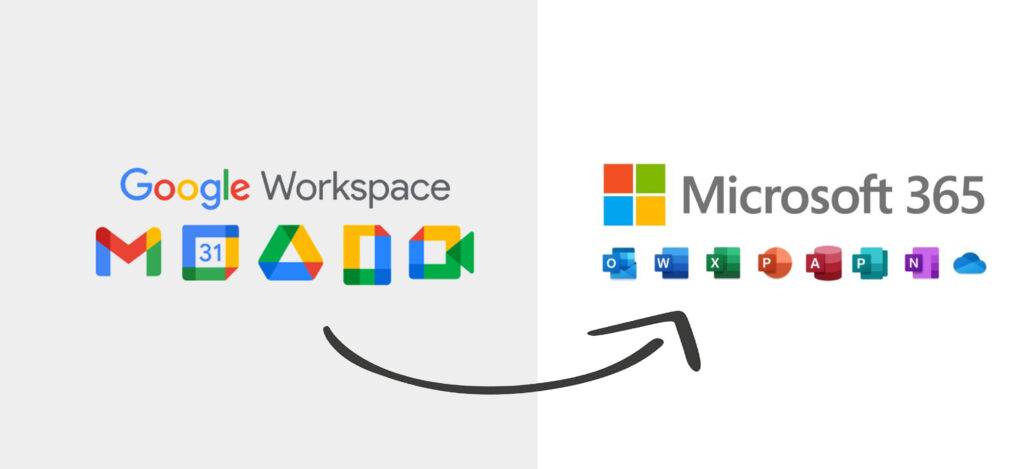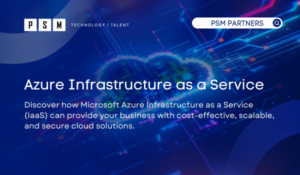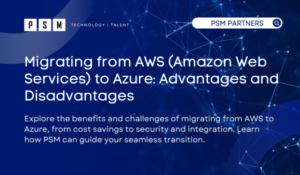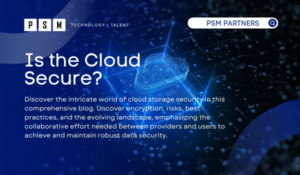Table of Contents
ToggleAs many organizations are migrating from Google Workspace to Microsoft 365, you may be wondering if Microsoft 365 is better than Google Workspace? How do you migrate to Microsoft 365? We will walk you through the framework of migrating to M365 and share helpful tips to help you plan and execute your migration.
Office 365 (now rebranded to Microsoft 365)
G Suite (now rebranded to Google Workspace)
While the decision to migrate is often made at the higher echelons of an organization, it is a daunting task for any IT team to handle. Our team at PSM has helped many organizations successfully transition from Google Workspace to Microsoft 365 through our thorough process laid out in this blog.
Benefits of migrating to Microsoft 365
Are you looking to migrate Google Workspace to Microsoft 365? Both Google Workspace and Microsoft 365 are cloud-based software as a service (SaaS) platforms and offer different characteristics and functionalities. A few reasons organizations are switching from Google Workspace to M365 is for ease of scalability, security, reliability, and efficiency. A few benefits of M365 are:
- Ease of use
- Microsoft 365 Collaboration
- Custom pricing
- Cloud storage
- Offline File Access Capabilities
- Office 365 applications
- Advanced Security and Threat Protection – Office 365 has many certifications such as (FISMA, SSAE16, HIPAA, SOC1 Type II, SOC2 Type II, ISO 27001, 27018, GDPR, EU Data Protection Directive)
Compare features:
Compare Pricing:
Planning your Migration to Microsoft 365 from Google Workspace
Like all migration projects, planning is paramount, and it starts with taking a health check of your source environment in addition to an inventory. Understanding what your organization uses in Google Workspace will help craft your migration approach. In most cases, organizations want to “lift and shift” their data to avoid any loss. Some organizations will opt to migrate only the most critical data, such as e-mail and cloud file storage, allowing themselves to build their new solution from the ground up to suit their needs. Both approaches pose various challenges. Due to the differences in each platform’s handling of data, there is a risk of losing fidelity. Knowing and understanding the differences will help select the right approach for your organization. In turn, this will increase your level of success in your migration and help you communicate/set expectations with your end-user base.
In addition to mapping out and inventorying your migration source, planning your Microsoft 365 tenant deployment is a major factor in crafting a successful migration outcome. Microsoft offers a variety of features and capabilities in areas like email and collaboration, identity and data security, data loss prevention, endpoint management, and many more. Creating a good foundation in all those areas will enable a smooth migration of data and user transition.
Migrating between Google and Microsoft productivity suites will impact most, if not the entire organization. Think business workflows, collaboration, data structures, compliance, etc. if you have not yet mapped out and documented your business workflows, now is a great time. Knowing how your migration impacts business units and how your organization responds to change will drive the adoption of the new platform.
Our tip here is to take as much time as possible to review and plan your migration. As the saying goes, “measure seven times, cut once.” Understand your data, business impact of migration, source platform, destination platform, and the limits of each as it relates to your migration project. Come up with a playbook, testing, validation scenarios, and back-out plans for each phase of your migration.
Selecting The Right Migration Tool
Microsoft offers native toolsets available to assist with migrating into its platform from a variety of sources; however, many organizations opt to go with a third-party tool such as BitTitan or SkyKick as the tool of choice. Selecting the proper migration tool to suit your organization’s migration goal will heavily influence the migration outcome. Your selection criteria will need to address a variety of factors like:
- Supported migration environments
- Privacy, security, and compliance (e.g., HIPAA, PCI, GDPR, etc.)
- What is and what isn’t migrated
- Endpoint management and configuration
- Support availability and options
- Licensing options and cost
Leveraging a third-party tool for your migration comes at a cost. With many licensing options available, it’s important to select the right option that gets your organization the most bang for the buck. Many third-party tools have complicated licensing schemes and multiple licensing bundle choices. However, cost should never be a deciding factor in selecting the right migration tool for your organization. Buy once, cry once, so long as your decision ensures you migrate everything you need and reduces post-migration headaches for your organization.
The best tip we can offer here is to do the due diligence to align the available migration tools with your migration needs. In most cases, a single tool will provide everything needed for a successful migration. Understand the limitations of your tool and how to mitigate them. Ensure that the tool can meet your desired security and compliance requirements.
Google Workspace to Microsoft 365 Migration Strategy
Once you have selected your migration tool of choice, it’s a good idea to settle on a migration strategy. Most tools will offer several options, but generally, most organizations will opt for a Pre-Staged Cutover, Big-Bang, or Co-Existence scenario.
The Pre-Staged Cutover is the most used migration strategy when migrating from Google Workspace to Microsoft 365. It enables the move of most of the organization’s data to the destination, allowing for time and space to complete other tasks involved in the migration, and reducing the time required for system cutover. The downside to using this method is the possibility of changes on the source not replicating to the destination as most tools merely copy data rather than sync it.
The Big-Bang strategy is often deployed by a smaller organization that can tolerate a service disruption, for instance, over the weekend. The Big-Bang Strategy is the simplest and most cost-effective method. Although, it does present some drawbacks, such as delays in data availability and access, missing data, and extended downtime depending on the size and scope of the amount of data being migrated.
The Co-Existence scenario is often reserved for the larger, more complex organizations that are unable to migrate everyone at the same time. For example, if the organization opts to move based on business unit requirements or has a low/no tolerance for service disruption. This is the costliest and most difficult strategy to implement. The entire migration process may take months to complete and often has various impacts across the organization.
Our tip for starting with Pre-Staged Cutover as your planned migration strategy, and then go through tabletop exercises to ensure it fits your organizational needs before considering other migration strategies.
Documenting your migration from Google to M365
As you plan and execute your Migration from Google to Microsoft 365, make sure your team documents every step of the way. Documentation not only is helpful to reference during the project but also makes post-project examination easy to analyze and discuss lessons learned. Documentation may also be required for compliance or audit purposes to show what and how things were completed.
One element, often overlooked, is end-user instruction. As you prepare to plan out your communication with your organization, consider what your users need to know as they are migrated. Be sure to run through the scenarios yourself and document your experience.
Our tip is to use a centralized, organized repository to keep your documents. Most organizations use a File Share, but if you get your Microsoft 365 tenant up and running, this may be a OneNote Notebook, a SharePoint Site, or a Teams Channel. Maintain a log of actions/steps, artifacts (e.g., screenshots, files, etc.), and document versions if changes occur. Create detailed end-user instructions that communicate the necessary tasks to complete during the migration lifecycle.
Steps for communicating your Microsoft 365 migration
Change is tough! Especially when migrating between productivity suites that affect every aspect of your business. As mentioned earlier, knowing how your migration impacts business units and how people in your organization work will drive the adoption of the new platform will be key for successfully migrating. A good communication strategy can ease the transition to the new platform in your organization by preparing your users for any disruptions, tasks they may need to perform, and changes in workflow.
When planning your communication, it is imperative to establish a timeline of emails and notices. Communicating properly will ensure your message is received well across multiple departments/business units. It’s important to start with a preliminary communication to set expectations with key stakeholders and end-users. Then, depending on the migration strategy, secondary, tertiary, pending, catch-up, and final communication emails will be necessary to keep everyone informed. The size of your organization and the scope of the migration will dictate your communication pattern.
Our tip here is to plan your communication emails/notices. If available, work with your organization’s HR and employee outreach department to maintain uniformity in your communication lingo. When migrating Google Gmail to Microsoft Exchange Online ensure you have a plan to communicate with your end-users before cutover and provide instructions on how to login to the destination.
Develop The Migration Runbook
Like any project, it’s crucial to develop a plan of action which dictates every step. This plan is typically referred to as a Migration Runbook, and its purpose is to outline every step of the migration (mostly high level), define timelines, responsibilities, expected outcomes, and a fallback plan.
The Migration Runbook will serve as a framework for the entire project and is typically broken up into several phases, as follows:
- Pre-Migration
- Migration Cutover
- Post-Migration
- Migration Cleanup
Be sure to assign key stakeholders and responsible parties to each task, with Primary and Secondary responsibilities, and set start and end dates. Define task types and detail steps that require change management. Keep things high level, but also make sure to call out any tasks that require detailed action. One example of this may be migrating a resource at a specific point in time to ensure data fidelity. Another example may be a call out for a VIP in a particular business unit.
Our tip here is to take your time in developing your Migration Runbook. Go over the plan and if warranted, perform a tabletop exercise to ensure all parties are in sync. The Migration Runbook tends to be a living framework, and it’s ok to make modifications as needed to meet the migration goals.
Execution and Wrapping Up
Everything up to this point will guide the execution of your migration project. The amount of time and effort put into planning will dictate the success of the migration. Once you’ve crossed your T’s and dotted your I’s, you’re ready to migrate from Google Workspace to M365.
Our tip here is to follow the plan you created, keep track of every step, document progress, and pitfalls, and refer to your Migration Runbook framework to keep you on track.
How We Can Help You
PSM is a technology consulting partner with a focus on client requirements, transparency, and agnostic solutions. Leverage our approach to strengthen your technologies and execute your IT initiatives. Delivered by a team of highly skilled and expertly trained engineers, PSM is committed to helping your business choose and execute the perfect migration strategy to execute your move from Google workspace to Microsoft 365.
Benefits of migrating to M365 with PSM:
- integrating end-user change management with the technical aspects
- Real-world experience with over 150K user deployments and migrations
- Use best practices focusing on high-end user satisfaction with minimal workflow disruption
- Smooth rollout with support based on past experiences
- Accelerated project timelines resulting from proven processes
- Reduction of costly risks and surprises during deployments
Contact us today and allow us to assist you with the successful execution of your migration from Google Workspace to Microsoft 365!
Related Insights
What is Azure Infrastructure as a Service?
In the increasingly competitive digital age, one-way businesses can stay...
Read MoreMigrating from AWS (Amazon Web Services) to Azure: Advantages and Disadvantages
Cloud technology has become an important part of the IT...
Read MoreIs the Cloud Secure?
In today’s digital age, data is the lifeblood of businesses....
Read MoreAbout the Author

Ilya Gofman
Passionate and accomplished Information Technology expert with a track record of 17+ years in designing, implementing, and maintaining innovative networks and technologies across various industries. Offers invaluable advice to clients, creates innovative solution architectures, and ensures that technology strategies align seamlessly with business objectives. Recognized as a Microsoft 365 Certified Enterprise Administrator Expert.




